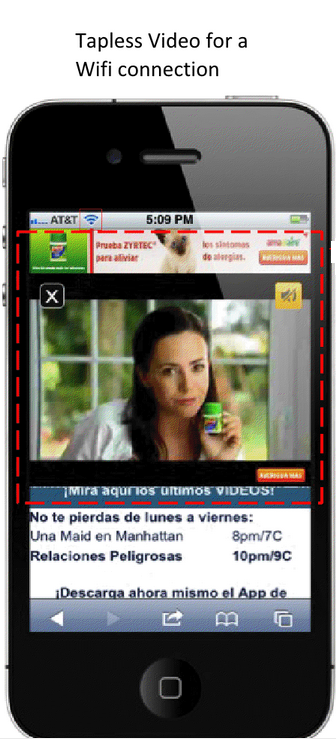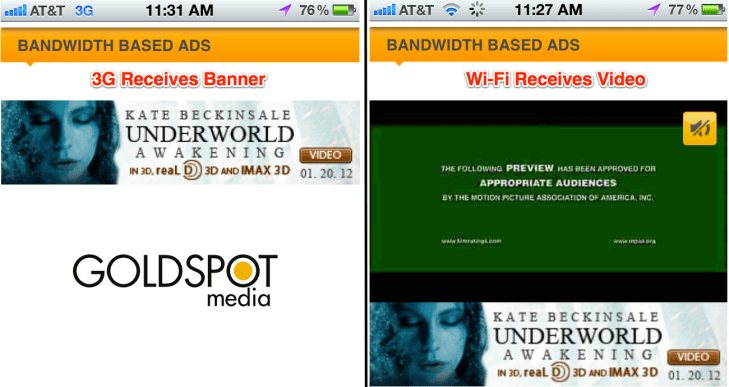Exclusive: GoldSpot Media has just unveiled its new “bandwidth-based ads”, a licensable technology that lets advertisers deliver a single mobile ad unit that appears as a simple rotating banner to viewers on 3G or mobile data, but as an auto-playing partial screen overlay video to viewers on wi-fi. Debuted on a new Zyrtec pharmaceutical campaign, you can compare the formats for yourself by turning wi-fi on or off.
GoldSpot’s tech could drastically increase the number of video impression an advertiser gets per dollar. This translates into improved campaign effectiveness and ROI, while preventing a viewer’s limited mobile data plan from being devoured by ads. Bandwidth-based ads will accelerate the metamorphosis of commercials into content by allowing interactive rich-media or even games to be served as mobile ads.
Here’s how mobile video ads often work today.
Regardless of their bandwidth, viewers see a banner that they have to tap before they see the promo video. Few people tap, and the video is rarely seen. GoldSpot’s CEO Srini Dharmaji tells me that if the ad had a $5 CPM, and a budget of $100,000, an advertiser would get 20 million impressions. If the ad had a high click through rate of 0.1%, just 20,000 people would see the video at a cost of $5 per view to the advertisers. Basically advertisers are throwing their money away. Alternatively, advertisers serve an auto-play video to everyone, and those on slow connections get their data plan drained and usually navigate away before the video even finishes loading
 Let’s run those numbers again with GoldSpot’s bandwidth video ad tech. Dharmaji says 60-65% of users consume content on wi-fi, and about 30-35% do so on 3G or mobile data. If the combined cost of GoldSpot’s platform and the ad inventory have a $20 CPM, on a $100,000 budget the advertiser would get 5 million impressions.
Let’s run those numbers again with GoldSpot’s bandwidth video ad tech. Dharmaji says 60-65% of users consume content on wi-fi, and about 30-35% do so on 3G or mobile data. If the combined cost of GoldSpot’s platform and the ad inventory have a $20 CPM, on a $100,000 budget the advertiser would get 5 million impressions.
Even if only 50% of viewers are detected to be on wi-fi and see the auto-play video in a partial screen overlay, the advertiser gets 2.5 million video impressions. That’s 4 cents per view instead of $5. Now do you see why this is a big deal?
Even if all those impressions aren’t full-length, full-screen views, the 2.5 million GoldSpot-powered ad views are going to have a much bigger impact than 20,000 dedicated views. Yes, some viewers could be annoyed by seeing more auto-play video ads, but at least they won’t have to pay for them. GoldSpot is now licensing the bandwidth-based technology to advertisers, agencies, and publishers. It works across ad networks, and provides consolidated performance reporting. It charges a CPM, and clients can use its drag-and-drop creation platform to format their ads.
Started in 2007, the Sunnyvale, CA GoldSpot Media has raised roughly $17 million between its seed, A, and B rounds, and now has more than 75 employees. It has over 50 individual and agency clients including the New York Times, Bloomberg, Chevy, and General Mills. It also provides opt-in device and geo-location ad optimization where viewers can select to provide data to see more relevant ads. Dharmaji calls GoldSpot a “hardcore technology company” with over 20 patents, but says those are for self-defense.
GoldSpot’s technology is a triple-win since in addition to making it money and getting advertisers a better ROI, it doesn’t suck up a user’s limited mobile data plan downloading videos if they’re not on wi-fi and don’t want to see them. Plus, since users on wi-fi are more likely to be relaxed rather than on the move, there’s a better chance that impressions lead to purchases or viewers internalizing an ad’s message.
As we shift to the post-PC era, delivering rich-media ads to tablets where they look great will become even more important. Dharmaji concludes “We give advertisers the power to build much more engaging ads. They have to think about how to increase ROI without pissing off the mobile consumer.”
